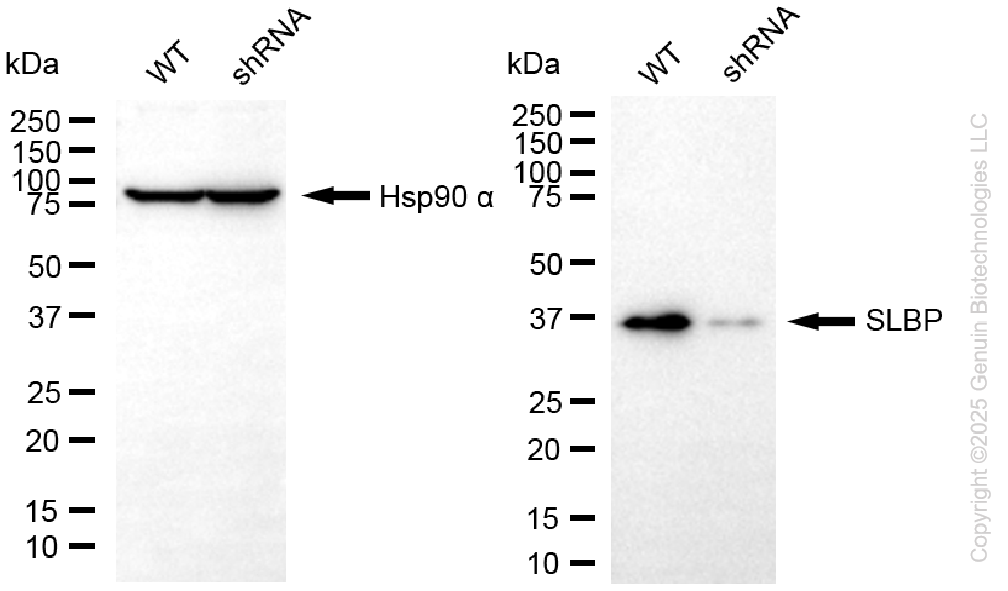KD-Validated Anti-SLBP Rabbit Monoclonal Antibody
Rabbit monoclonal antibody
- SPECIFICATION
- CITATIONS
- PROTOCOLS
- BACKGROUND

Application
| WB |
|---|---|
| Primary Accession | Q14493 |
| Reactivity | Human |
| Clonality | Monoclonal |
| Isotype | Rabbit IgG |
| Clone Names | 25GB4485 |
| Calculated MW | Predicted, 31 kDa; observed, 37 kDa |
| Gene Name | SLBP |
| Aliases | SLBP; Stem-Loop Histone MRNA Binding Protein; HBP; Stem-Loop (Histone) Binding Protein; Histone RNA Hairpin-Binding Protein; Stem-Loop Binding Protein; Histone Binding Protein; Histone Stem-Loop Binding Protein; Histone Stem-Loop-Binding Protein; Hairpin Binding Protein, Histone |
| Immunogen | A synthesized peptide derived from human SLBP |
| Gene ID | 7884 |
|---|---|
| Other Names | Histone RNA hairpin-binding protein, Histone stem-loop-binding protein, SLBP, HBP |
| Name | SLBP |
|---|---|
| Synonyms | HBP |
| Function | RNA-binding protein involved in the histone pre-mRNA processing (PubMed:12588979, PubMed:19155325, PubMed:8957003, PubMed:9049306). Binds the stem-loop structure of replication-dependent histone pre-mRNAs and contributes to efficient 3'-end processing by stabilizing the complex between histone pre-mRNA and U7 small nuclear ribonucleoprotein (snRNP), via the histone downstream element (HDE) (PubMed:12588979, PubMed:19155325, PubMed:8957003, PubMed:9049306). Plays an important role in targeting mature histone mRNA from the nucleus to the cytoplasm and to the translation machinery (PubMed:12588979, PubMed:19155325, PubMed:8957003, PubMed:9049306). Stabilizes mature histone mRNA and could be involved in cell-cycle regulation of histone gene expression (PubMed:12588979, PubMed:19155325, PubMed:8957003, PubMed:9049306). Involved in the mechanism by which growing oocytes accumulate histone proteins that support early embryogenesis (By similarity). Binds to the 5' side of the stem-loop structure of histone pre-mRNAs (By similarity). |
| Cellular Location | Cytoplasm. Nucleus. Note=Polyribosome-associated (PubMed:12588979). Localizes predominantly in the nucleus at the G1/G2 phases and the beginning of S phase (PubMed:12588979). Through the S phase, partially redistributes to the cytoplasm (PubMed:12588979) Binding to histone mRNA is necessary for cytoplasmic localization (PubMed:12588979). Shuttles between the nucleus and the cytoplasm (PubMed:15829567). Imported in the nucleus by the Importin alpha/Importin beta receptor (PubMed:15829567) |
| Tissue Location | Widely expressed.. |

Thousands of laboratories across the world have published research that depended on the performance of antibodies from Abcepta to advance their research. Check out links to articles that cite our products in major peer-reviewed journals, organized by research category.
info@abcepta.com, and receive a free "I Love Antibodies" mug.
Provided below are standard protocols that you may find useful for product applications.
If you have used an Abcepta product and would like to share how it has performed, please click on the "Submit Review" button and provide the requested information. Our staff will examine and post your review and contact you if needed.
If you have any additional inquiries please email technical services at tech@abcepta.com.














 Foundational characteristics of cancer include proliferation, angiogenesis, migration, evasion of apoptosis, and cellular immortality. Find key markers for these cellular processes and antibodies to detect them.
Foundational characteristics of cancer include proliferation, angiogenesis, migration, evasion of apoptosis, and cellular immortality. Find key markers for these cellular processes and antibodies to detect them. The SUMOplot™ Analysis Program predicts and scores sumoylation sites in your protein. SUMOylation is a post-translational modification involved in various cellular processes, such as nuclear-cytosolic transport, transcriptional regulation, apoptosis, protein stability, response to stress, and progression through the cell cycle.
The SUMOplot™ Analysis Program predicts and scores sumoylation sites in your protein. SUMOylation is a post-translational modification involved in various cellular processes, such as nuclear-cytosolic transport, transcriptional regulation, apoptosis, protein stability, response to stress, and progression through the cell cycle. The Autophagy Receptor Motif Plotter predicts and scores autophagy receptor binding sites in your protein. Identifying proteins connected to this pathway is critical to understanding the role of autophagy in physiological as well as pathological processes such as development, differentiation, neurodegenerative diseases, stress, infection, and cancer.
The Autophagy Receptor Motif Plotter predicts and scores autophagy receptor binding sites in your protein. Identifying proteins connected to this pathway is critical to understanding the role of autophagy in physiological as well as pathological processes such as development, differentiation, neurodegenerative diseases, stress, infection, and cancer.



